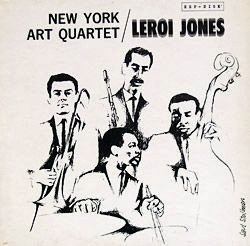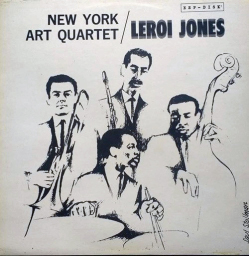|
|
180
Reviews: “Roswell Rudd
assembled the newly formed New York Quartet for an afternoon recording session
at Bell Sound Studios in midtown “Alto
saxophonist John Tchicai co-formed the New York Art Quartet in 1964 out of the
ashes of the New York Contemporary Five. Enlisting trombonist Roswell Rudd (who
arranged some of the latter group's book), the NYAQ was initially to include the
Five's rhythm team of bassist Don Moore and drummer J.C. Moses. However, once
drummer Milford Graves sat in, the group's pan-rhythmic die was cast. A number
of bassists past through the ensemble in its short life ? in addition to Lewis
Worrell (featured here), Steve Swallow, Eddie Gomez and Reggie Workman occupied
the bass chair. On the heels of the present album, they recorded once more for
One of the things that always set the group's ESP date apart from contemporary brethren is its inclusion of a poem, “Black Dada Nihilismus” by Amiri Baraka(LeRoi Jones), which is woven into the group's fabric. ”Nihilismus” is a beat follow-up to Eliot's “The Wasteland” in the clothes of mid-60s New York, “cool” as dead, disheartened and disaffected with no place in any artistic or racial community, yet somehow affirming singularity as solitude. In a way, the inclusion of Baraka's (Jones) poem perfectly mirrors the in- betweenness of the group, who certainly had grand claims as to their music as art-music, creative and experimental, but whose approach to that very artfulness was always brusque and extremely “street.” The horns sit
out for “Nihilismus,” which is propelled by the thrum of Worrell's bass and
|
| Recorded in New York City on November 26, 1964. White labels/black print - with 156 5th Avenue address. The 156 address is on the cover as well. Back of cover presents catalogue nos. 1001-28 in a 7 x 9 matrix. Together these points suggest that this reissue was issued (early) 1966. This conclusion is based on Paul Costuros' ESP-disk discographical work at http://www.totalshutdown.com/espdisk/espaddress.html |
| Recorded November 26, 1964 in New York City. This version: - yellow labels with black lettering - the back cover shows the whole ESP catalogue up till BUD-1 - the address on the back cover is Krumville, New York 12447 Released between 1969-1972 according to back cover address |
|
|
|
This version: - Thick cardboard cover (paste-on-style) - White labels with black lettering - back cover shows the whole ESP catalogue up till BUD-1 - address on back cover and labels: ESP-DISK', 290 West End Avenue, New York, N.Y. 10023 - Printed in U.S.A. on front & back cover - no printing on spine |
Roswell Rudd assembled the newly formed New York Quartet for an afternoon recording session at Bell Sound Studios in midtown Manhattan. They were joined by a small, youthful appearing individual, the poet Amiri Baraka. Their engineer was the late Art Crist, an accomplished pianist. I was introduced to Lewis Worrell, Amiri Baraka and John Tchicai. The group was short lived. I heard them again 40 years later, when they reassembled for a concert at the South Street Seaport in New York City, opening for Sonic Youth at the invitation of Thurston Moore. -- Bernard Stollman
|
Roswell Rudd: trombone |
||||||||||||||||||||||||
|
||||||||||||||||||||||||
|
Compositions by Roswell Rudd (ESP Disk' Ltd. ASCAP & Roswell Music BMI) except track 6 by John Tchicai (ESP Disk' Ltd. ASCAP) and track 2 by Amiri Baraka (ESP Disk' Ltd. ASCAP). Credits Recorded on November 26, 1964 at Bell Sound Studios, NYC.
Engineering by Art Crist. Original cover illustration by Saul Stollman. Digital
remastering by Douglas McGregor. Design & Layout by Miles Bachman &
Peov. "Cooking through contradiction, the New York Art Quartet
cut some of the most powerful music in the free jazz underground." -
Clifford Allen, All About Jazz "The rep of this LP as a touchstone in any respectable library of free jazz remains ironclad. Now, as at the time of its pressing, the music looks beyond such celebratory canonization and stands on its own terms." - Derek Taylor, Bagatellen |
(ESP-Disk')
 |
|
 |
|
.jpg)
.jpg)